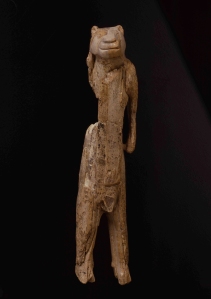Ice Age Art
May 1, 2013 § 2 Comments
The Ice Age Art show at the British Museum ends with a quote from the Surrealist writer Georges Bataille:
The artistic light that emanates from Greece is the light of broad day. This early light of artistic dawn is less certain… But early morning light is the most dazzling of all. (Prehistoric Painting: Lascaux or the Birth of Art)
Lascaux’s paintings, discovered in 1940, are around 15,000 years old. The oldest objects in the BM exhibition are 30-40,000 years old: the earliest examples of art, made by migrants from Africa heading into Europe as the ice age began its slow thaw. We can picture a landscape of treeless tundra running from the South of France across the Danube Valley to the Russian steppe, where people lived in caves or tents sewn from animal hides, a landscape shared with reindeer and bison, bears and wild horses, and extinct creatures such as mammoth and auroch. All of these appear, carved in the round from mammoth tusk, antler or bone, or incised in fine detail. These are not crude artefacts, but things so acute and full of life that they inspire awe. There is a breathtaking little horse, a rushing bison displayed so that we face her head on, and the famous lion-man from southern Germany, an apparently benign smile on his animal face.
As a hybrid he stands out; in general the animals are precise in their realism. The human figures, however, derive their beauty from abstract proportions. Where the former amaze by their perfectly caught immediacy, the latter are troubling and mysterious: large-bellied, broad-hipped female forms that to our eyes convey some idea of fertility. Did they celebrate pregnancy and childbirth? Matriarchal power? Are they talismanic? Who knows. One of these is the earliest ceramic human figure, 32,000 years old. There is also the first human portrait, a tiny ivory head of a woman from 26,000 years ago, with succinct and eerily idiosyncratic features.
In the first three rooms, where the oldest objects are shown, I felt exhilarated, yet almost disbelieving, that such a harsh external world could combine with nothing more than the imagination and be so potent, so exquisite. Certainly, it was a world richly populated with marvellous and sometimes dangerous creatures that provided their hunters with food, clothing, tools, shelter and the physical materials of art. But this was art newborn, coming out of darkness without a parent, without any other art to teach it. Art before there was agriculture, seeking to make the world intelligible or render the mystery of what was not amenable to understanding.
The recent radio four series, Noise: a Human History, began in the Arcy-sur-Cure caves, in Burgundy, where the rock paintings are around 30,000 years old. There, a group of musicologists carried out an experiment on the caves’ acoustic qualities and found that those points with the greatest resonance coincided with the location of the paintings. To account for this phenomenon, widely verified elsewhere, there were theories about echoes from the spirit world… It’s significant that the earliest musical instruments, flutes made from bone, date from this period, and you can see one of these in the Ice Age show, carved from the wing-bone of a vulture. Now, there’s a metamorphosis, and this exhibition is full of them. You can see carved birds too, swans. I asked myself whether in that cold, treeless landscape there were any songbirds for the first musicians to learn from.
I’ve never seen any of the prehistoric cave paintings at close quarters, only on television and in Werner Herzog’s fine film Cave of Forgotten Dreams, which explored the Chauvet cave in southern France (32,000 years). He described what he saw as “the beginnings of the modern human soul” and I much prefer this formulation to the one the Ice Age exhibition’s organisers use: “the arrival of the modern mind”.
Herzog’s “soul” and Bataille’s image of a flaming dawn (all the more striking given his status as Surrealism’s dark side) suggest no comparisons with modern intellect. However much archaeologists and others attempt to interpret this very ancient art, they and we can only speculate and wonder. We’ll never know how our remote ancestors thought some 30-40 millennia ago. How their world structured their thinking lies beyond our reach, far beyond the ancient civilisations whose works fill the rooms of the British Museum. Babylonian and Sumerian cultures lead us a mere 5000 years into the past and they are strange enough. This art was made on the other side of mythic time, and that may be why it is so moving.
One thing is clear, and never clearer: art is no luxury; it’s a deep necessity. And, even in the worst of times, it will surely persist.




